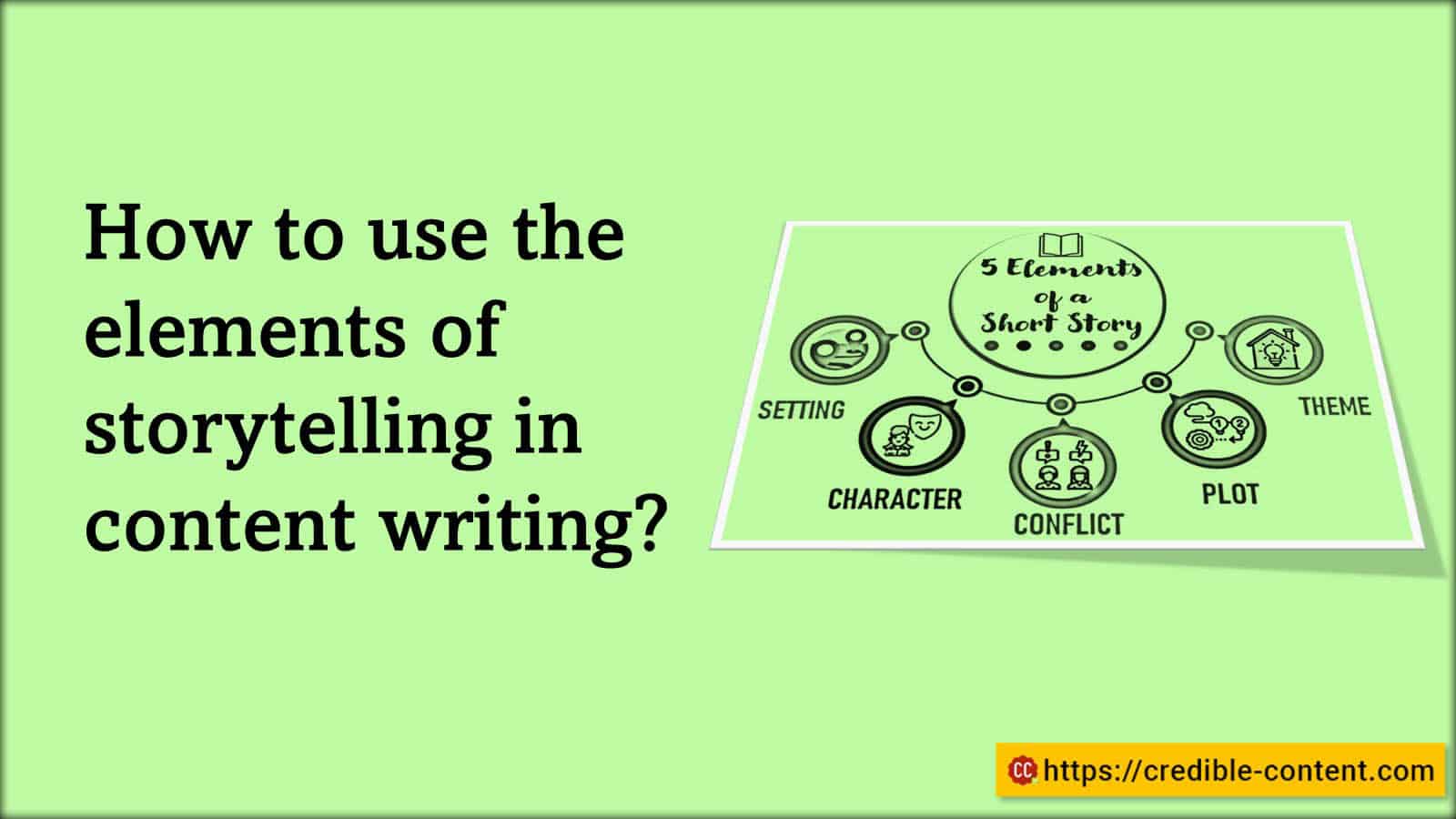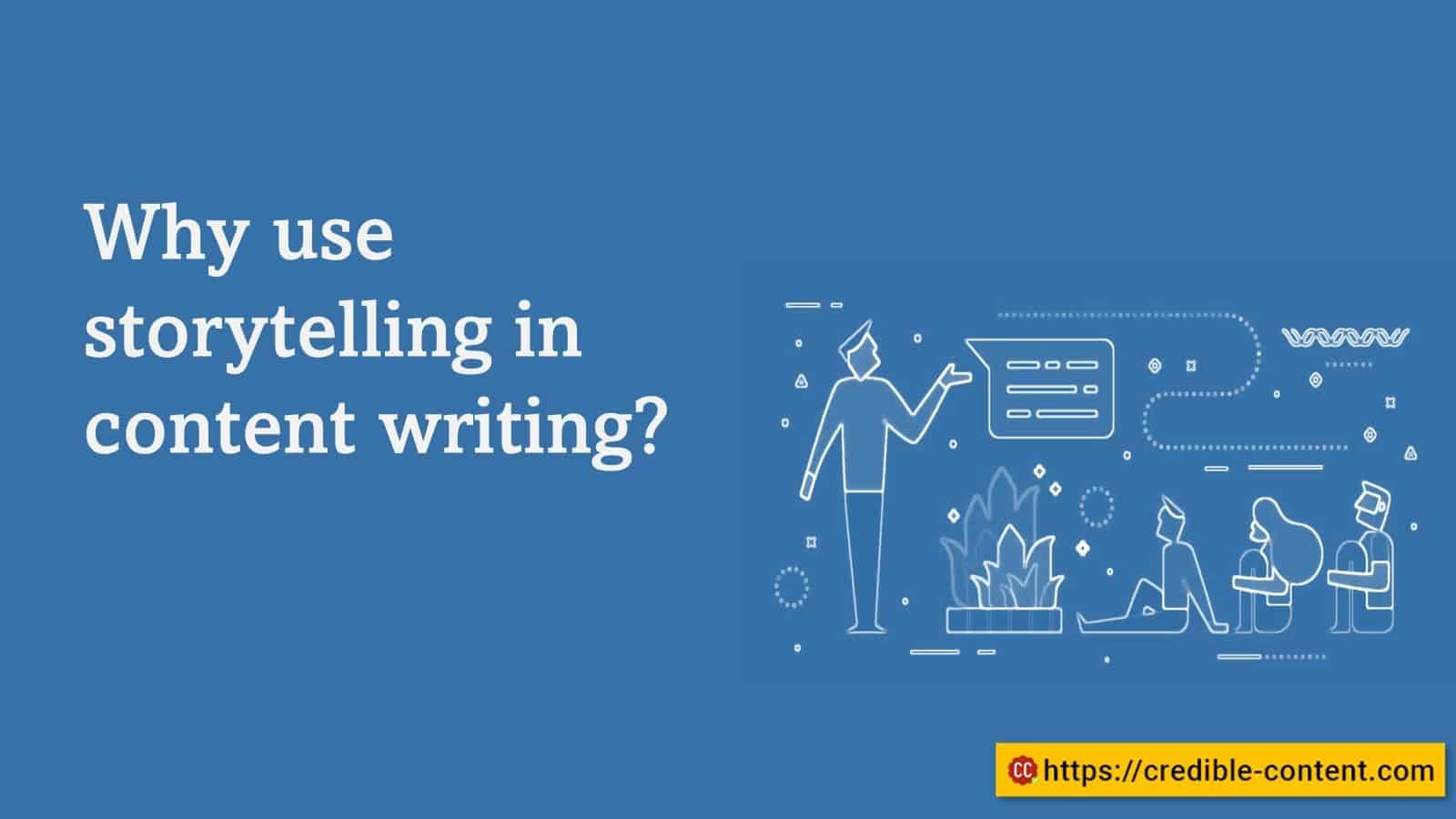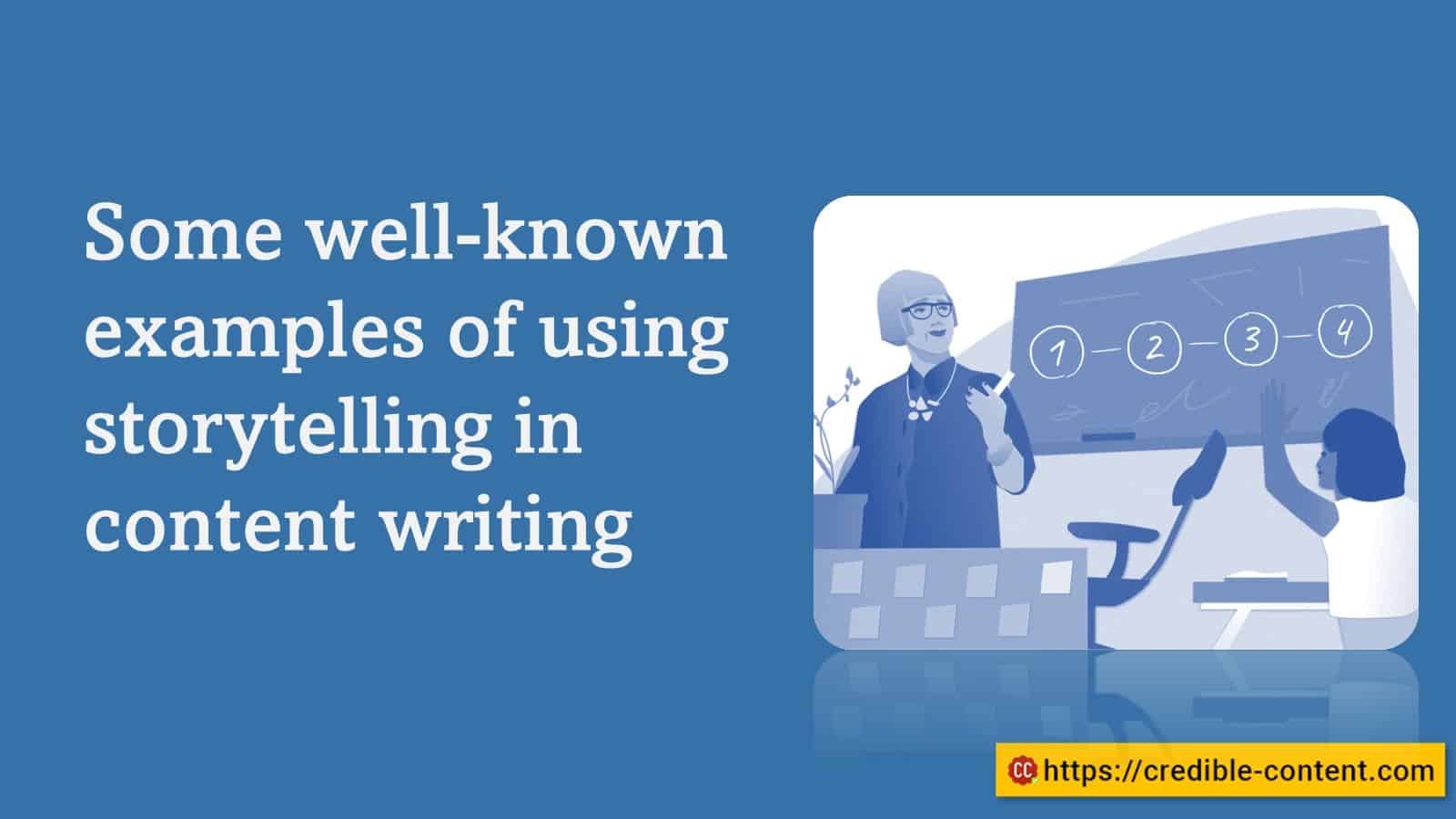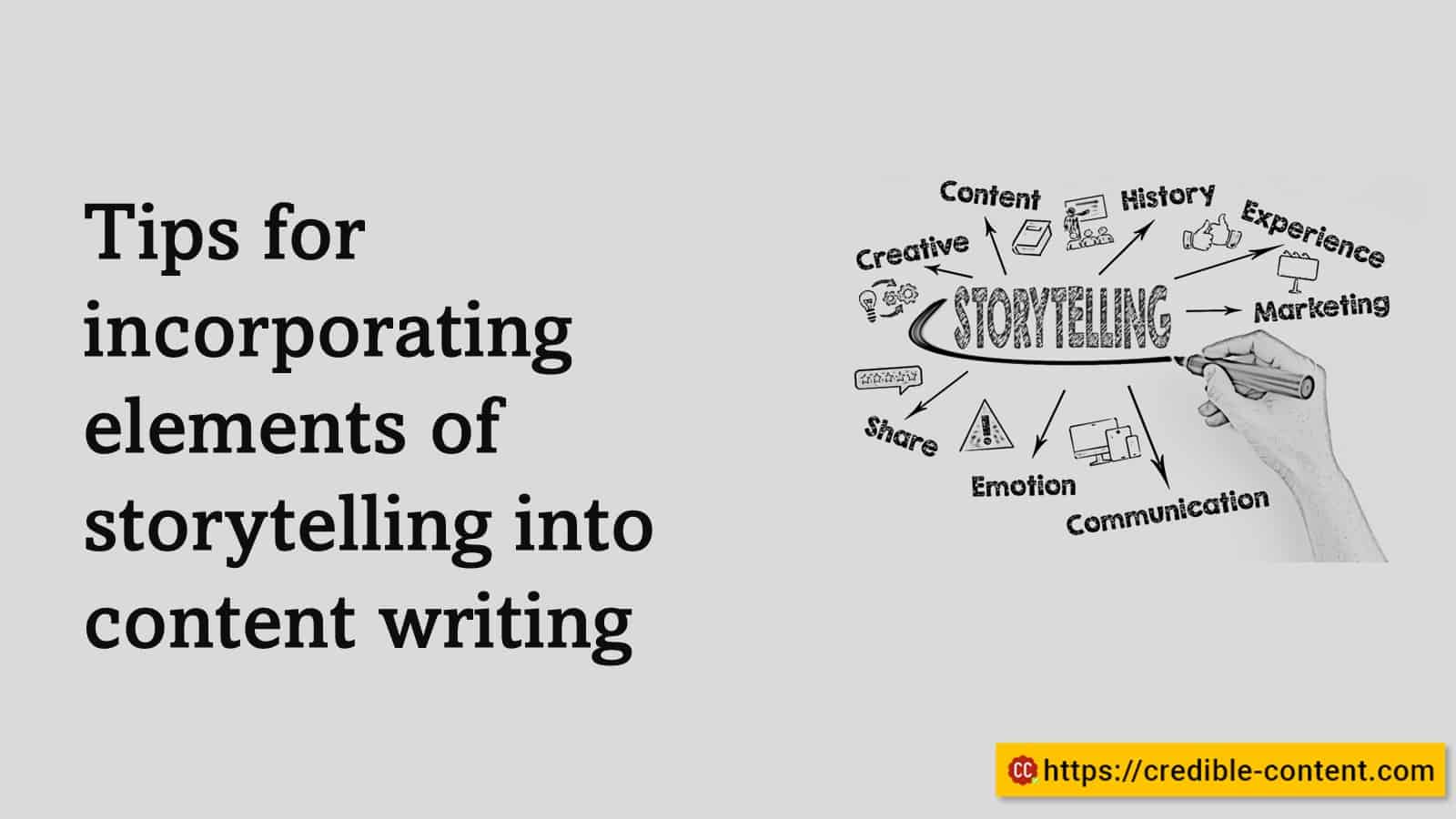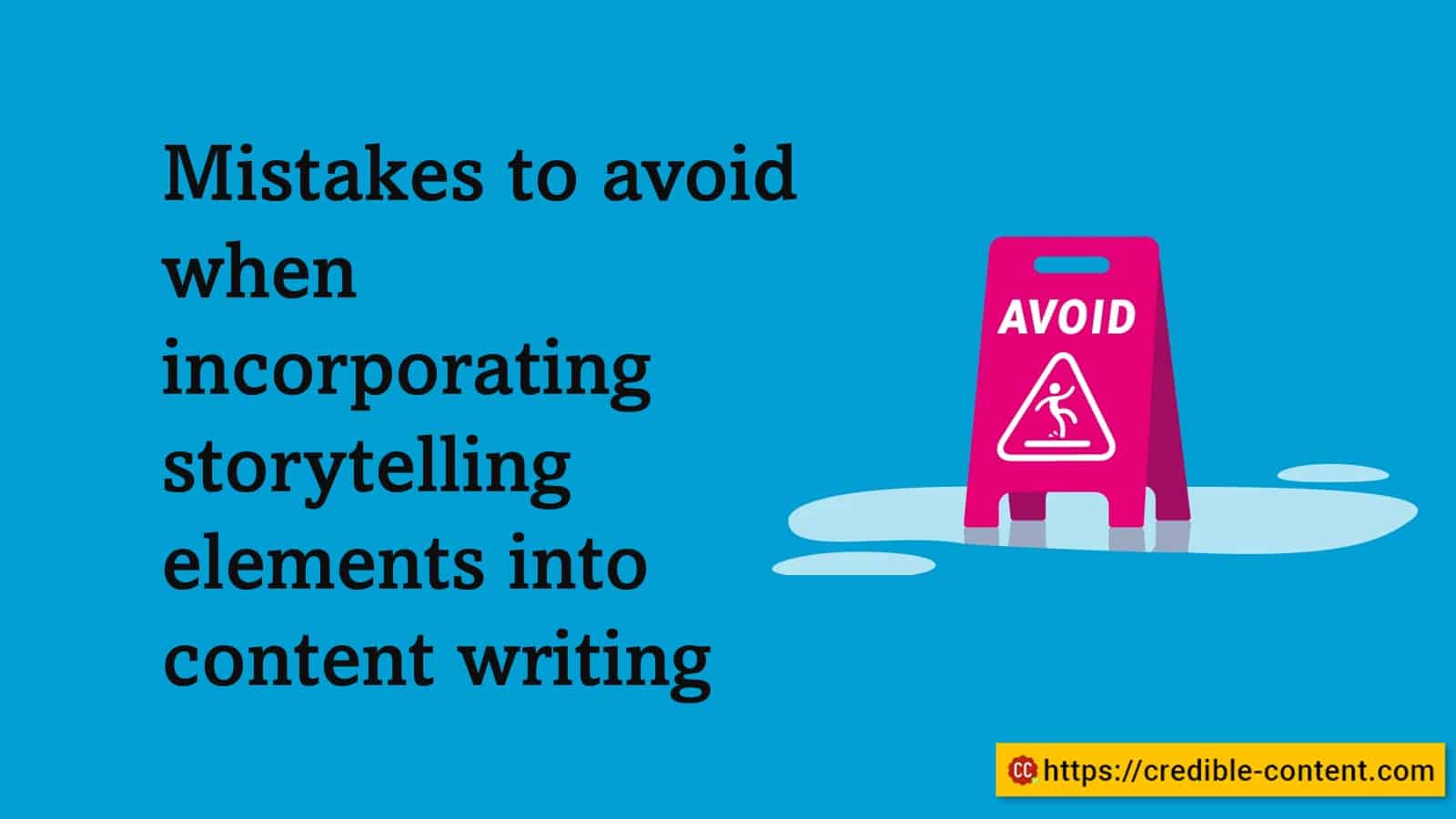The main elements of storytelling are:
- Plot: Sequence of events driving the story forward.
- Characters: Individuals with distinct personalities and relationships.
- Setting: Time, place, and social context of the story.
- Conflict: Central problem or tension that creates obstacles.
- Theme: Underlying message or idea conveyed by the story.
- Point of View: Perspective from which the story is told.
- Tone: Overall mood or attitude of the narrative.
- Dialogue: Spoken or written communication between characters.
- Symbolism: Use of objects or images to represent abstract ideas.
- Pacing: Rhythm and tempo of the story’s progression.
Why use storytelling in content writing?
Read: What is storytelling in content writing?
Imagine reading a blog post that simply lists facts and information.
It might be informative, but it can feel dry and uninspiring.
Now, picture reading a blog post that begins with a captivating story, setting the scene and introducing relatable characters.
Suddenly, you’re intrigued and invested in finding out what happens next.
Whether you’re writing a blog post, creating a video, or even delivering a presentation, storytelling can transform your content into something truly remarkable.
It adds depth, emotion, and relatability, making it a captivating experience for your audience.
Some known examples of storytelling being used in content writing
Warby Parker
I have read their story in many content writing books. It is a company that sells eyeglasses on the Internet.
Eyeglasses used to be very expensive in the US. Despite being not able to see properly, many people wouldn’t buy new eyeglasses simply because they couldn’t afford them.
Warby Parker identified a niche, created a story around their brand, and started selling eyeglasses that were highly affordable.
The company repeatedly uses the stories of its founders and customers to make an emotional connection with new and existing buyers.
The name Warby Parker was inspired by two characters from Jack Kerouac’s novels, Warby Pepper and Zagg Parker.
For every pair of eyeglasses sold on their website, they donate a pair to someone in need through their partnership with VisionSpring and then they also share the stories with their readers.
Google often use a storytelling to demonstrate the impact of its products and services on people’s lives.
There are many commercials tell heartfelt stories of how individuals are improving their lives using different Google products.
GoPro
GoPro, the wearable camera company, uses user-generated content to tell captivating stories of adventure, extreme sports, and personal experiences.
They encourage their customers to share their own stories captured with their GoPro cameras.
Certainly! Here are 15 benefits of storytelling in content writing, presented in subsections and bullet points, written in a conversational style:
Benefits of Storytelling in Content Writing
1. Engagement and Attention
- Storytelling in content writing captures the reader’s attention and keeps them engaged throughout the content.
- It creates a compelling narrative that draws readers in.
2. Memorability and Recall
- Stories make content writing more memorable, helping readers retain information.
- When readers remember the story, they also remember the key messages conveyed in the content.
3. Emotional Connection
- Storytelling through content writing elicits emotions, allowing readers to connect with the content on a deeper level.
- Emotional resonance helps build a stronger bond between the reader and the content.
4. Relatability and Empathy
- Stories make the content relatable, as readers can see themselves or others in the characters or situations.
- By evoking empathy, your content writing fosters a connection and understanding between the reader and the content.
5. Humanizing the Message
- Stories humanize the content by adding a personal touch, making your content writing more relatable and authentic.
- It brings the content to life and makes it more appealing to the reader.
6. Differentiation and Uniqueness
- Storytelling sets your content writing apart from competitors by presenting it in a unique and memorable way.
- Unique stories make the content stand out and attract more readers.
7. Simplification of Complex Concepts
- A story simplifies complex ideas or concepts, making them more accessible and understandable to the reader.
- It breaks down complex information into digestible narratives.
8. Building Trust and Credibility
- An anecdote establishes trust by sharing authentic experiences, testimonials, or case studies.
- It enhances the content’s credibility and helps readers perceive it as reliable and trustworthy.
9. Enhancing Brand Identity
- A story through content writing reinforces the brand’s identity by conveying its values, vision, and mission through content.
- It helps shape the brand’s narrative and create a consistent brand image.
10. Fostering Curiosity and Intrigue
- Stories arouse curiosity and intrigue, making readers eager to know what happens next.
- They keep readers hooked and encourage them to explore the content further.
11. Encouraging Social Sharing
- Compelling storytelling through content writing prompts readers to share the content with others, extending its reach and visibility.
- Shared stories have the potential to go viral and attract a wider audience.
12. Inspiring Action and Influence
- Stories have the power to inspire action, encouraging readers to take desired steps or make informed decisions.
- By influencing readers’ behavior, storytelling can drive conversions or desired outcomes.
13. Longer Engagement and Time Spent
- Storytelling increases the time readers spend with the content, as they are engrossed in the narrative.
- Longer engagement through content writing in this manner leads to better understanding and absorption of the content’s message.
14. Versatility and Adaptability
- Storytelling in content writing is adaptable to various content formats, such as articles, blog posts, videos, or social media posts.
- It can be tailored to suit different platforms and audience preferences.
15. Entertainment Value
- Storytelling adds an element of entertainment to the content, making it enjoyable for readers.
- Engaging and entertaining content leaves a positive impression and encourages readers to return for more.
Incorporating storytelling into content writing brings numerous benefits, from enhanced engagement and memorability to building trust, differentiation, and inspiring action.
But you already know about storytelling. In this blog post I’m going to discuss how to use different elements of storytelling in content writing.
Tips for Incorporating Elements of Storytelling into Content Writing
Hook the Reader from the Start
- Begin your content with a captivating opening that grabs the reader’s attention and sparks curiosity.
- In storytelling through content writing, the first sentence sets the tone for the entire narrative.
Establish a Clear Narrative Arc
- Structure your content writing with a clear beginning, middle, and end to create a coherent storyline.
- Introduce a problem, present a solution, and conclude with a satisfying resolution.
Craft Engaging Characters
- Bring your content writing to life by developing relatable and memorable characters that readers can connect with.
- Create personas or use real-life examples to make the storytelling more impactful.
Evoke Emotions
- Incorporate emotional elements into your content writing to engage readers on a deeper level.
- Share personal stories, use vivid descriptions, or tap into universal emotions.
Use Descriptive Language
- Paint a vivid picture with your words by incorporating descriptive language and sensory details into your content writing.
- Engaging storytelling appeals to the reader’s senses and creates a more immersive experience.
Create Tension and Conflict
- Introduce conflicts or challenges in your content writing to keep the reader engaged and eager for resolution.
- Storytelling thrives on tension and builds anticipation for what comes next.
Show, Don’t Just Tell
- Instead of stating facts, use storytelling techniques to show the reader the information through anecdotes, examples, or visuals.
- Engage the reader’s imagination by painting a mental picture.
Use Dialogue and Conversational Tone
- Incorporate dialogue or conversational tone into your content writing to make it more engaging and relatable.
- By using natural language, storytelling becomes more conversational and interactive.
Establish a Central Theme
- Define a central theme or message that ties your content together.
- Storytelling with a clear theme helps convey your intended meaning and leaves a lasting impression.
Build Suspense
- Engage readers by introducing suspenseful elements or cliffhangers that keep them eager for the next part of the story.
- Storytelling thrives on anticipation and keeps readers invested.
Incorporate Plot Twists
- Surprise your readers with unexpected turns or plot twists in your content writing.
- Twists add excitement and keep the audience engaged throughout the narrative.
Use Storytelling Structures
- Explore storytelling structures like the hero’s journey, three-act structure, or problem-solution approach to give your content a well-defined framework.
- These structures help create a cohesive narrative flow.
Utilize Metaphors and Analogies
- Enhance your content writing with metaphors and analogies that make complex ideas more relatable and understandable.
- Storytelling with metaphoric language adds depth and clarity to your message.
Include Conflict Resolution
- Resolve conflicts or challenges introduced in your content writing to provide a satisfying conclusion.
- Storytelling with resolution creates closure and a sense of fulfillment for the reader.
Employ Foreshadowing
- Foreshadow future events or outcomes in your content writing to create anticipation and intrigue.
– Storytelling with foreshadowing builds suspense and keeps readers engaged.
Note: Foreshadowing is a literary device in which a writer hints at or suggests an event that will happen later in the story. Foreshadowing can be used to create suspense, build excitement, or simply add depth and complexity to a story.
Use Authentic and Personal Stories
- Incorporate real-life anecdotes, personal experiences, or testimonials to add authenticity to your content writing.
- Storytelling with personal stories establishes credibility and strengthens the connection with the reader.
Create a Compelling Opening Line
- Craft a captivating opening line that immediately piques the reader’s curiosity or poses a thought-provoking question.
- The first sentence sets the tone for the storytelling and entices readers to continue reading.
Inject Humor and Wit
- Infuse your content writing with humor and wit to engage readers and create a memorable experience.
- Storytelling with a touch of humor adds a lighthearted element that can resonate with the audience.
Vary the Pace and Tone
- Keep your storytelling dynamic by varying the pace and tone throughout your content writing.
- Mix moments of tension, reflection, and excitement to maintain the reader’s interest.
Use Visuals to Support the Story
- Complement your content writing with relevant visuals such as images, videos, or infographics that enhance the storytelling.
- Visual elements add depth and help readers visualize the narrative.
Include Cliffhangers and Call-to-Actions
- Leave readers wanting more by incorporating cliffhangers or intriguing endings in your content writing.
- Additionally, use call-to-actions that prompt readers to take the next step, such as subscribing or sharing.
Embrace Vulnerability and Authenticity
- Share vulnerable and authentic moments in your storytelling to create a genuine connection with your readers.
- Openness fosters trust and allows readers to relate on a deeper level.
Tailor Stories to Your Target Audience
- Customize your storytelling to resonate with your specific target audience.
- Understand their needs, interests, and preferences to craft narratives that speak directly to them.
Create a Sense of Belonging
- Use storytelling to create a sense of community and belonging among your readers.
- Connect with them by sharing experiences or narratives that foster a shared identity or common ground.
Practice Storytelling Consistently
- Hone your storytelling skills by practicing regularly in your content writing.
- The more you practice, the more natural and impactful your storytelling will become.
Incorporating storytelling elements into your content writing allows you to create engaging, memorable, and relatable narratives that resonate with your audience.
Certainly! Here are 5 mistakes to avoid when incorporating elements of storytelling into content writing, presented in subsections and bullet points. I’ll use a conversational style with a personal tone, using “you” and “I,” and repeat the words “storytelling” and “content writing” for SEO purposes:
Mistakes to Avoid When Incorporating Elements of Storytelling into Content Writing
Losing Sight of the Main Message
- Avoid getting so caught up in storytelling that you lose sight of the core message or purpose of your content writing.
- Keep your storytelling aligned with the primary objective to ensure it supports and enhances the intended message.
Overcomplicating the Storytelling
- Don’t overwhelm your readers with complex storytelling techniques or convoluted narratives in your content writing.
- Keep the storytelling clear, concise, and easy to follow to maintain reader engagement and understanding.
Neglecting Relevance to the Audience
- Avoid storytelling that doesn’t resonate with your target audience in your content writing.
- Tailor your stories to be relevant, relatable, and meaningful to the specific needs and interests of your readers.
Ignoring the Importance of Editing and Proofreading
- Don’t underestimate the significance of editing and proofreading your storytelling in content writing.
- Carefully review your work to eliminate errors, ensure clarity, and maintain the flow of the narrative.
Forgetting the Call-to-Action
- Don’t forget to include a clear call-to-action in your storytelling in content writing.
- Guide your readers towards the desired next step, whether it’s subscribing, sharing, or taking a specific action.
By avoiding these storytelling mistakes, you can ensure that your content writing effectively incorporates storytelling elements to engage, captivate, and inspire our audience.
Tips on Incorporating Storytelling into Content Writing for Uninteresting and Boring Products
Incorporating storytelling into content writing for seemingly uninteresting products can be a creative challenge, but it’s definitely possible.
Storytelling can captivate your audience, make your content more engaging, and help connect your products with the emotions and needs of your target audience.
Here are some tips to incorporate storytelling into your content writing for uninteresting products:
Sure, here’s a revised version that incorporates the phrase “content writing”:
Find the human angle
When it comes to content writing, storytelling can breathe life into even the most uninteresting products.
Uncover the human stories behind your product and infuse them into your content writing. Show how it can make someone’s life easier or more enjoyable.
Highlight relatable challenges
In content writing, it can be a challenge to make a seemingly boring product sound exciting. But what if we focus on the common problems your audience faces?
By acknowledging their challenges through storytelling in your content writing, you can create a relatable narrative that demonstrates how your product provides a solution.
Paint a vivid picture through storytelling in your content writing
Imagine this: You are transported to a different world, where your product is the hero.
Using descriptive language and storytelling techniques, you can help your audience visualize the benefits and the experience of using the product.
Share customer success stories
Here’s a content writing secret: nothing beats a genuine customer success story when it comes to making a product relatable and interesting.
Showcase the experiences of your satisfied customers, making them the protagonists of the narrative in you are weaving.
Create a character-driven narrative
You can treat your product like a character in a story, giving it unique traits and qualities.
By personifying your product through storytelling in your content writing, you can create a captivating narrative that engages your audience and makes them care.
Infuse humor and wit into your content writing
I know writing for your product might not seem like a comedy goldmine, but humor can work wonders.
You can inject some light-heartedness, wit, or clever wordplay into your content writing to entertain your readers and keep them engaged.
Tap into emotions through storytelling
Emotions are a powerful tool in content writing, and you can use them to your advantage, even with uninteresting products.
Evoke emotions like curiosity, nostalgia, or even a sense of anticipation through storytelling in your content writing to captivate your audience.
Incorporating storytelling elements into content writing can transform even the most uninteresting products into captivating narratives.
By harnessing the power of storytelling, you can engage readers on a deeper level, evoking emotions and creating a connection.
To do so, it’s crucial to find the human angle and highlight relatable challenges. You can paint a vivid picture through descriptive language, share customer success stories, and create character-driven narratives.
Infusing humor, tapping into emotions, and using storytelling formats also play a vital role.
When writing about uninteresting products, you can uncover the hidden stories behind them, showcase how they solve common problems, and even inject suspense and curiosity.
By mastering the art of storytelling in content writing, you can turn the mundane into something truly fascinating, capturing the attention and imagination of your audience.

